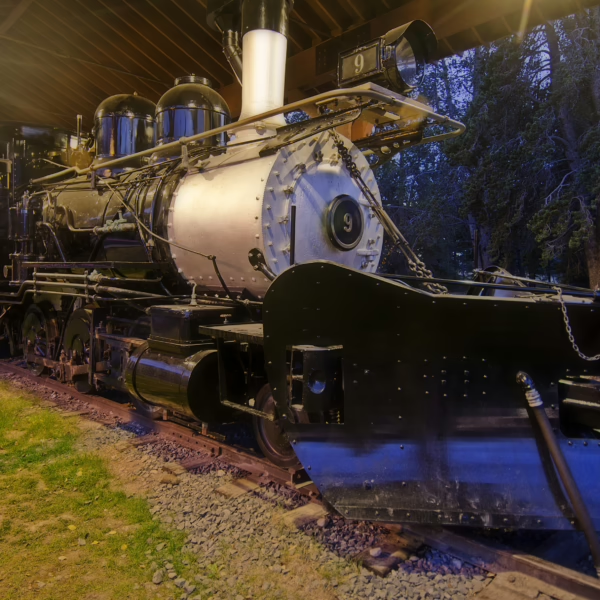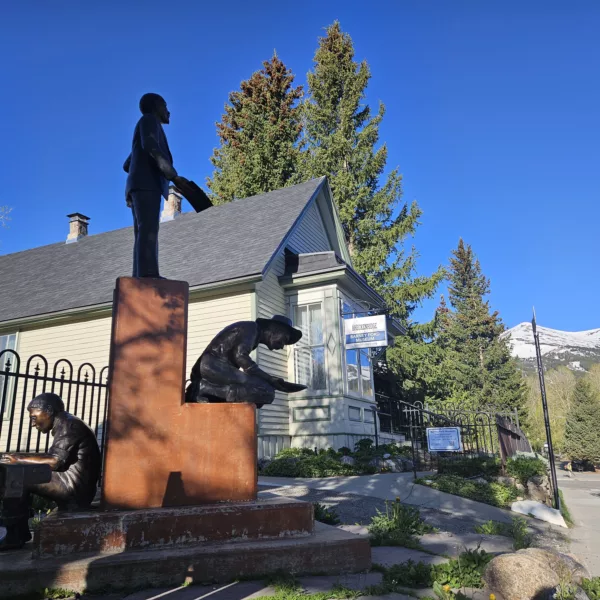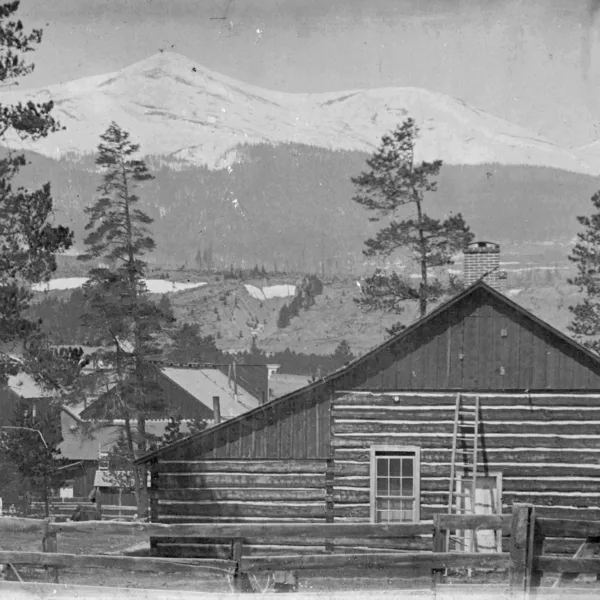A Day in the Life of a Miner
March 14, 2022 | Category: Breckenridge History
The day started early and ended late for miners and others working in the mines of Summit County. Mining companies expected their workers to be down in the mine at 7:00 a.m. ready to go. This required the miners to rise early and walk or ride to work, sometimes in heavy snow and the darkness of the winter months, from a family home, boarding house or perhaps company housing.
They first stopped in the dry room where the clothing they had worn the day before waited, dirty but dry, in baskets or on hooks. Miners wore Levi’s or baggy pants tied at the ankles to keep the pants above the tops of their boots and out of standing water. Above their waist, they wore an undershirt open at the neck or nothing at all. Some wore a woolen “union” undergarment beneath their shirt or work pants. On their feet, they wore sturdy shoes or brogans to keep feet safe and dry. On their head, they wore a felt hat hardened by repeated dipping in resin or linseed oil. When they finished dressing, they picked up their drill steels, hammers and sledges, lunch, candle holders, candles and any other hand tools they might need and headed for the ladder in the manway.
The last thing the miners did before descending was pick up their “brass,” a piece of metal about the size of a quarter with their individual number on it. At the end of the day, they returned their “brass” to its specific hook on the wall. In case of an emergency, it could be ascertained quickly by looking at the missing brasses which miners remained in the mine.
Candles illuminated the mines of Summit County in the late 1800s. The candles, nine inches long and three-quarters of an inch in diameter, burned slowly, producing little smoke. Made of hard tallow, they kept their shape in the high humidity and elevated temperatures of a mine. Men often had to purchase the candles themselves for five cents each. One of the three candles needed for a ten-hour shift might be attached to the hat brim with clay. If an individual miner didn’t wear a candle on his hat, he might use a wrought iron candle holder wedged into a rock wall or wooden timber. Men purchased the candle holders from a merchant or ordered them from a catalogue. In some cases the mine’s blacksmith made the six-to-twelve-inch-long candle holders. Midway between a loop at one end and a long point at the other, a second loop held a candle. Some candle holders had a hook on top so that they could be hung from a timber.
Other workers such as trammers, who pushed the ore cars to the surface, and muckers, who shoveled crushed rock into the ore cars, wore outfits similar to those worn by the miners. The muckers used D-handled scoops called idiot sticks or muck sticks to fill as many as 18 ore cars in a ten-hour work day. Blacksmiths wore heavy leather aprons for protection. Timbermen, responsible for cutting the timbers for tunnel walls and ceilings, wore bib overalls for protection from splinters as they carried the heavy timbers and cribbed the tunnel surfaces.
Workers usually climbed down the ladder in the manway. They called it “walking to work.” They preferred not to ride the bucket, which swayed as it descended, into a dark mine. Once in place, the miners began the exhausting job of drilling holes for their charges.
The men experienced a wide range of conditions in the mines: warm and humid; cool and humid; and everything in between. In tunnels below the water table, moisture seeped from the walls and ceilings. Standing water might cover the floor, making it slippery and hazardous.
Miners commonly used single and double jacking in Summit County mines. Single jacking with a four-pound hammer worked best in narrow spaces or with overhead drilling. One miner held the drill steel, striking it 50 times per minute with the four-pound hammer, turning the drill steel after each strike. Where space allowed, double jacking prevailed. While one person held and turned the drill steel, the other swung the eight-pound sledge 25 times per minute. The men changed positions every 15 minutes so that one could rest. In very large areas, triple jacking could be done. Two men swung eight-pound sledges, alternately striking the steel while a third turned the steel in the drill hole.
Drill steels varied in length and width. The “starter” or “bull” steel measured one foot long with a 1½ inch-wide flared bit. Made of Black Diamond rod, steels in a set increased in length by six inches while the flared bit decreased by one thirty-second of an inch. The longest steel available reached three feet in length and had a three-quarter inch bit. Anything longer could bind in the hole, making it useless. The flared corners of the bit were of greater importance in penetrating the rock than the sharpness of the front edge of the bit.
Before the invention of dynamite, miners used black powder (a mixture of saltpeter, sulfur and charcoal) as their explosive. Black powder did not have a reputation for reliability. Misfiring and misfired holes, called “hang-fire,” presented problems. William Bickford, in 1831, invented a fuse used with black powder. His fuse, made of black powder wrapped in jute, strong twine and water-proof tape, burned one inch in 30 seconds.
When Alfred Nobel invented dynamite, it replaced unreliable black powder. One pound of dynamite did the work of two and two-third pounds of black powder. Besides causing headaches and nausea, dynamite had another huge problem: it became unstable at temperatures just above 40 degrees Fahrenheit. Some mines had metal dynamite warmers, looking like a candle mold sitting atop a water reservoir, to keep the sticks warm at night. If they didn’t have a metal dynamite warmer, miners filled knitted dynamite warmers, shaped like elongated ski caps, with the sticks of dynamite and took them to bed at night.
Mines did not produce ore constantly. Much time had to be spent drilling holes, blasting, mucking, timbering and testing to determine the path of the vein.
Since many of the workers came from Cornwall, lunch often consisted of a pasty (pass’ tee), a one-dish meal of vegetables and meat encased in a crust, and eaten like a sandwich. Sometimes fruit filled the crust. Some held meat in one end and fruit in the other. Candle stubs kept the food warm. Miners hammered a ring of nails into a board. Putting a lighted candle stub in the middle of the ring, they set their lunch pail on the nail heads. Soup, pasty, coffee or tea stayed quite warm.
Unsanitary conditions created by animal and human waste and rotting food scraps caused suffocating smells. A dirt-filled box or powder box served the “call of nature” in a mine. The task of cleaning the box fell to the low man on the mine hierarchy–the tool nipper whose primary job included distributing and collecting tools.
At the end of the long, tiring day, the men gladly rode the bucket to the surface. As many as six men might cram into the bucket, dangling arms and legs on the outside. As the bucket rose, it swayed, sometimes injuring an arm or leg. The men returned their brass and tools and headed to the drying room where their clothing would be kept overnight. Companies said that keeping the clothing meant it would be dry and warm when the workers returned the next day. But the real reason? High-grading.
When miners worked for themselves, high-grading did not present a problem. When men became employees of impersonal mining companies financed by investors from “elsewhere,” high-grading blossomed. Men hid pieces of gold in secret pockets, boot heels, lunch pails, hat bands, uneaten food, false-crowned hats and under fingernails. People accepted it as a way to increase the average wage of $3.00 per day.
In the late 1800s, mining dominated the economy of Breckenridge. A simple philosophy reigned supreme: Mining came first; everything else placed second. The newspaper editor offered this opinion: The veins of Summit County would employ miners for centuries. They would first wash away the boulders, gravel and soils, exposing the minerals. The area would be uninhabitable but it would first provide the world with a great amount of mineral wealth.
written by Sandra F. Mather, PhD




